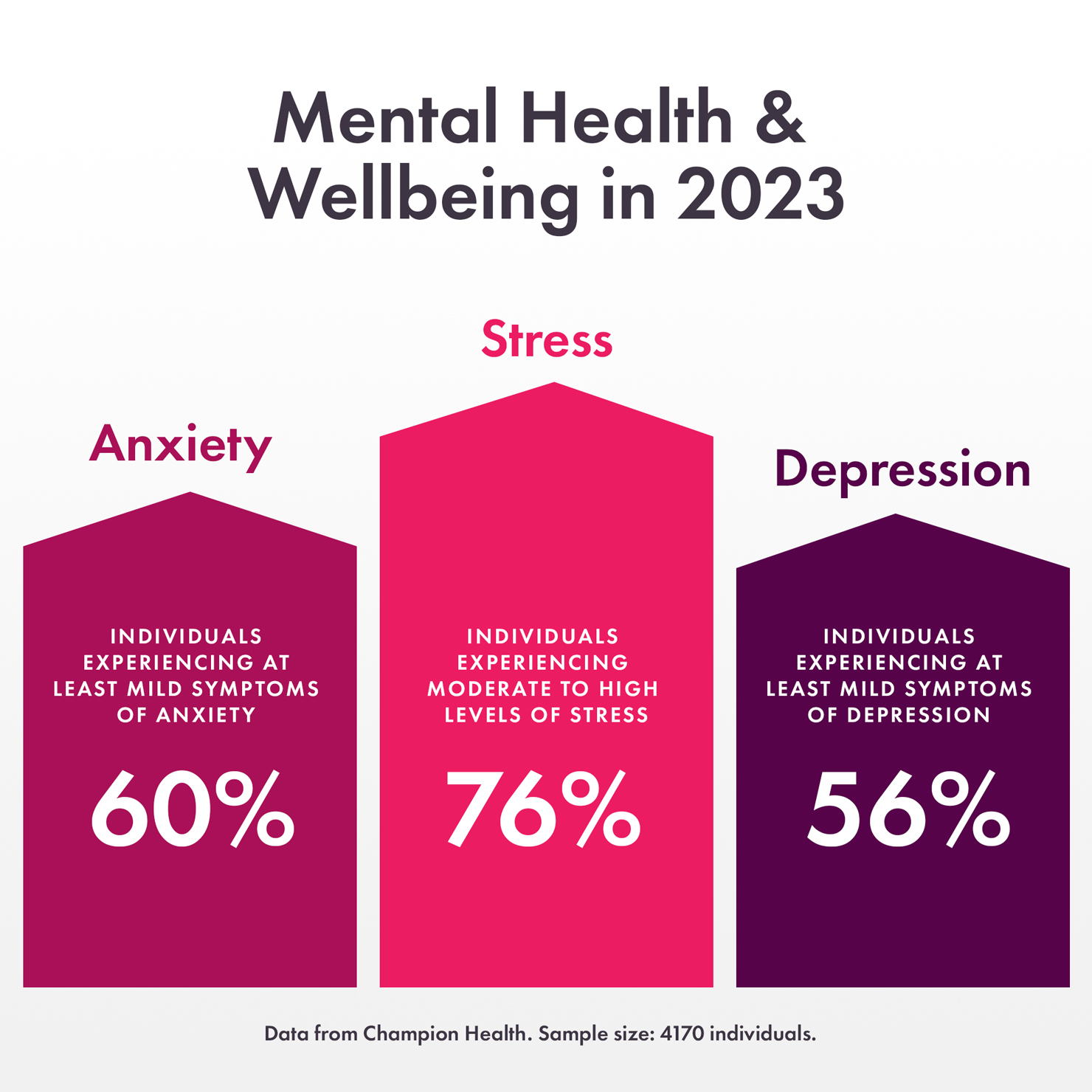Recent years have put workplace wellbeing under the microscope. From the stresses caused by the pandemic, to the musculoskeletal challenges posed by ad-hoc homeworking set-ups, introducing wellbeing at work – and getting it right – has never been so challenging.
But what exactly is wellbeing at work? Watch this video to find out from Laura Dallas, Head of Product at Champion Health.
It has arguably never been more important for organisations to place employee wellbeing at the top of their priorities. But where do you start when it comes to introducing wellbeing at work?
There‘s no one-size-fits-all approach to wellbeing, and the challenges for HR and leaders are constantly evolving. This can make it difficult to know how to go about introducing workplace wellbeing initiatives. With that in mind, these are our top tips for introducing wellbeing at work:
- Get the conversation started
- Consider all areas of wellbeing
- Engagement is critical
- Encourage employees to get moving
- Involve your leaders
- Start slow
- Look to the experts
Whether you’re just starting out, or reinvigorating existing initiatives, read on for a closer look at our seven tips for introducing wellbeing at work.
1. Get the conversation started
The first stage of introducing wellbeing at work is getting the conversation started. Workplace wellbeing initiatives are unfortunately still battling against the stigma of discussing health issues at work.
You may find that there is a reluctance among employees to open up to their colleagues or managers when they are struggling with their mental or physical health, for fear of how they will be perceived or treated if they do.
The stigma surrounding mental health is particularly concerning because it’s such a widespread issue. Anonymised data from our platform suggests that 25% of workers are experiencing clinically relevant symptoms of depression, and 76% are experiencing moderate to high levels of stress.

Many employees are wary of discussing their mental health concerns and some are worried about the impact that it will have on their careers.
However, these issues aren’t just limited to mental health; 47% of women take time off work due to menopause-related symptoms, without telling their bosses.
Other employees will be suffering from back pain, sleeping badly or struggling with relationship issues, but not talking about it at work.
By stimulating conversations about wellbeing throughout your business, you’ll help to break down the stigma surrounding workplace health and start building a culture of openness and support.
Start with something as simple as regularly asking your colleagues how they’re doing. You don’t have to have all the answers – simply making it clear that you care is a great way to start introducing wellbeing at work.
2. Consider all areas of wellbeing
Through our experience supporting organisations with their workplace wellbeing strategies, it’s clear that there’s a large emphasis on mental health in existing strategies.
While it is wonderful to see that mental health is being taken seriously by businesses, wellbeing doesn’t stop there. Just as we all have mental health, we all have physical health, musculoskeletal health and financial health. We all need to look after our nutrition and we all need to prioritise our sleep.
So, when you’re introducing wellbeing at work, be sure to not only focus on mental health, but on all areas of wellbeing. This will allow you to address workplace health issues that are typically ignored and eventually build a comprehensive wellbeing strategy that caters for the needs of each employee.
3. Engagement is critical
Lack of engagement is often the downfall of workplace health programmes. You could have the best wellbeing initiatives, the best tools and the best plan in the world, but if your employees don’t engage your impact will be minimal.
If you’re introducing new wellbeing initiatives, you need to put the right strategies in place to ensure engagement with them. For example, you could try incentivising your workforce to actively participate, or utilising the power of social proof by sharing your own experiences of the platform.
Many initiatives survive initial implementation and then fall by the wayside; if you want to see sustained improvement in your organisation, you have to prioritise sustained engagement.
There are a number of ways you can do this. You could make space every week for employees to engage with wellbeing initiatives (by scheduling calendar invites) or you could use your communication channels to regularly signpost your initiatives.
Taking the time to prioritise engagement will enhance the effectiveness of your wellbeing initiatives, and boost the wellbeing of your workforce.
4. Encourage your employees to get moving
Developing a healthy work environment is more difficult now than ever before because it is far harder to ensure that home-based workstations are ergonomically healthy,
The increase in remote working is diluting the effectiveness of workplace gyms and bike to work schemes. Plus, the reduction in commuting means that desk-based workers are moving even less than they already were.
That’s why encouraging your employees to get out of their chairs is a simple but effective workplace health initiative. And the benefits extend to all employees, whether they’re office-based or working from home.
As little as five minutes of walking every hour has been proven to enhance mood and boost productivity. So, take a stand on sitting, and encourage your employees to get moving by leading the way with straightforward initiatives.
For instance, if there is a company video call that is more than an hour long, schedule in a 5-minute break and encourage your employees to leave their chair during that time. Changes like this might seem small, but they can work wonders for the health and productivity of your workforce.
5. Involve your leaders
One thing is clear when it comes to introducing wellbeing at work: change must start from the top. Unless you lead by example, your positive wellbeing initiatives won’t embed themselves in your organisation.
Ensure your leaders are fully on-board with your initiatives before you start. Posters and emails can help with engagement, but you need to influence the culture of your organisation. The best way to do that is from the top.
To make your wellbeing strategy successful, your senior leadership team should publicly engage with and support it. Where they lead, the business will follow, and the more they talk about it, the more it will become part of the fabric of the organisation.
6. Start slow
If you’re just beginning to introduce wellbeing in your office, be sure to set realistic goals and avoid doing too much too quickly.
By overwhelming your colleagues with complex wellbeing solutions, you may be doing more harm than good. Start simple instead. This could be as easy as building daily rituals that include five simple things each employee can engage with to boost their health – such as getting out of their chair every hour.
If everyone sees your initiatives as something that is achievable from the outset, you’ll avoid alienating potential detractors who view changing their habits less positively.
7. Look to the experts
We understand that HR and wellbeing professionals must master many roles and resolve distinct challenges – from mental health to financial health. To support your employees, it can be tempting to become an expert in each area of health, but that’s often not realistic when balancing your regular job demands.
Instead, look to the experts to help build your wellbeing initiatives. There are thousands of expert organisations – both in the third sector and private sector – creating fantastic resources to support professionals like you.
At Champion, we created the Champions Framework – a resource designed to help you improve your mental fitness.
We also particularly love the resources created by REBA and CIPD – both massively respected industry organisations.





